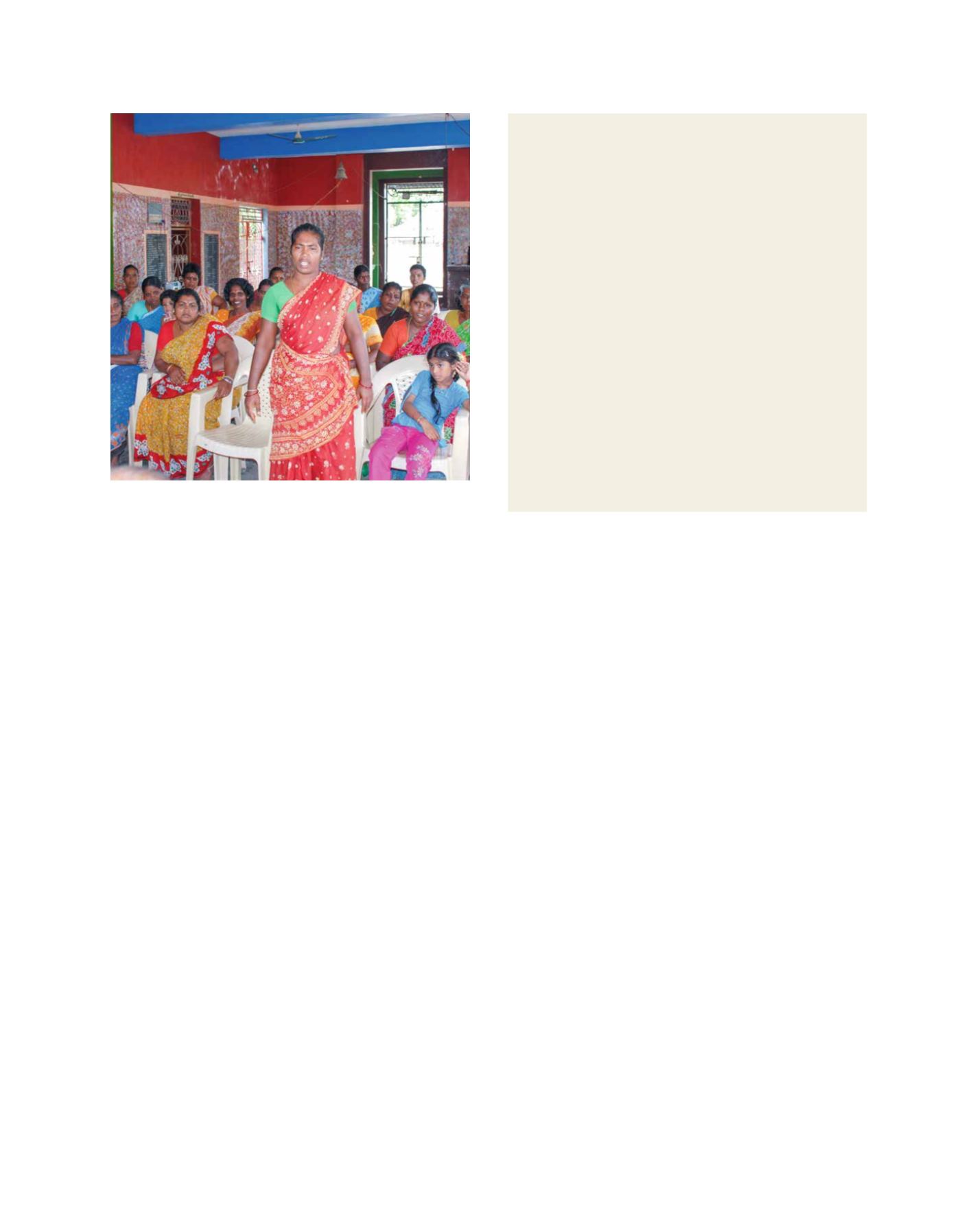

[
] 60
Bangladesh as well as encouraging savings and creating rural
capital through the formation of SHGs.
In Maldives, women are largely engaged in the production
of Maldives Fish or smoked and dried tuna. Therefore, the
extent of their participation is determined by the availability
of fresh tuna. In recent years, the Government of Maldives
has encouraged the domestic fishing fleet to target both skip-
jack and yellowfin tuna. The Government has also recently
announced the Fisheries and Agriculture Diversification
Programme, under which soft loans (at 6 per cent interest)
will be provided to cooperative societies for value addition
and enhancing productivity.
In Sri Lanka, as in the other countries of the region, women
are mostly involved in fish processing and to a small extent in
marketing. The role of women is more visible in inland fisher-
ies and fish farming. The policy objective of the Government
of Sri Lanka is to ensure sustainable production through
community participation. The legal framework of the country
emphasizes stakeholder consultation – which potentially
engages women in the decision-making processes.
In India, women have played multiple roles in fisheries,
apart from their key role in raising the family. Policy supports
have facilitated improvements in their skills, the formation of
women’s cooperatives and SHGs and access to credit. Besides
their traditional role in post-harvest activities, involvement
is diversifying to areas such as seaweed farming and other
mariculture activities. The new draft Marine Fisheries Policy
of 2016 aims to strengthen the role of women in fisheries.
It proposes that the “Government will … further enhance
support by way of forming women cooperatives; women-
friendly financial support schemes; good working conditions
that would include safety, security and hygiene and transport
facilities for retail marketing; encouragement to take up small-
scale fishing, value addition activities; and also play an active
role in fisheries management.” In addition, it also suggests
that the coastal provinces should consider increasing the area
presently reserved for artisanal fishing. Such an action could
see the revival of the role of women in active fishing as artisa-
nal fishing mainly comprises the marginal section of society
catering to local markets. The policy objective of reduction in
post-harvest losses could help ensure better financial remu-
neration for women engaged in fisheries.
In spite of the multidimensional roles of women in fisher-
ies, their contributions often go unnoticed. There are several
reports of discrimination in wages and working conditions,
especially in the processing sector. Various social indicators
such as sex ratio and literacy rate also suggest that there is
a need to empower women. While these features may be a
reflection of society at large, in the context of fisheries, it
implies that women in practice are far from the decision-
making processes at the macro level.
Experiences so far on the involvement of women in the
marine fisheries sector show that the removal of constraints
can lead to their productive engagement. The first constraint
is that despite women playing a significant role in distribu-
tion and post-harvesting, they do not have much power to
influence the process. The second constraint is that their role
in economic activities is not reflected in their social status
as captured in sex ratio and literacy rate differentials. The
third constraint is that unlike men, examples of successful
women’s enterprises show the necessity of group effort. In
other words, solo ventures by women possibly have little
chance of success. These factors could inhibit unlocking the
full potential of women in enterprise and decision-making.
While these constraints are mostly part of the position of
women in the larger society, the fisheries sector can bring
in changes by moving to principles as described in the FAO
Voluntary Guidelines on Small-scale Fisheries Governance.
Securing women’s role in fisheries
The Voluntary Guidelines for Securing Sustainable Small-scale
Fisheries (VG-SSF) is an international effort in securing women’s
role in fisheries.
Rights and duties are the cornerstone of any successful governance
mechanism. The 1995 FAO Code of Conduct for Responsible Fisheries
(CCRF), which documented best practices in fisheries governance,
arguably focused on this. To further support implementation of the
CCRF, in June 2014, 143 FAO member countries adopted the VG-SSF.
As the title suggests, these guidelines focus on small-scale fisheries,
which constitute about 90 per cent of the global fishery.
The VG-SSF aims at ensuring human rights and dignity, gender
equality and equity, transparency and rule of law, participation,
accountability and social responsibility by empowering small-scale
fishing communities, including both men and women, to participate
in decision-making processes, and to assume responsibilities for
sustainable use of fishery resources. At the same time, the differences
between women and men have been acknowledged and the guidelines
suggest that specific measures should be taken to accelerate de
facto equality. The guidelines call for the state to secure equitable and
appropriate tenure rights to fishery resources (marine and inland) with
special attention paid to women. The guidelines also call for ending all
types of discrimination against women and ensuring secure workplaces
and fair wages while providing them with the necessary support to avail
different resources – such as finance and training.
A stakeholder consultation with fisherwomen from Mudasalodai Fish Landing
Centre, Tamil Nadu, India
Image: Y S Yadava
A B
etter
W
orld
















